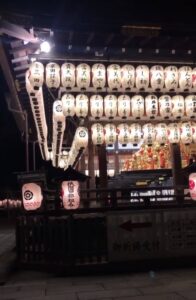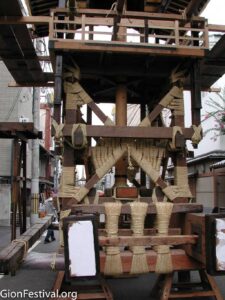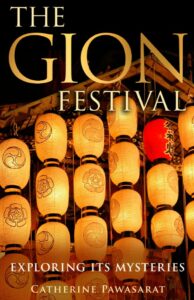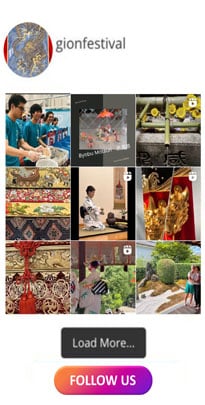Gion Matsuri 2021: festival-goers pay respects at the festival’s parent Yasaka Shrine. Are they praying for an end to covid, the Gion Festival’s original purpose? Image courtesy Jorie Johnson.
Here’s a covid update on the Gion Festival 2021. Priding itself in being virtually unstoppable, the Gion Festival continues this year. However, it’s a smaller scale than normal years due to Covid.

The golden portable mikoshi shrines for Yasaka Shrine deities are staying at the shrine this year, not being carried through Kyoto streets as usual. Note the lack of shrine visitors. Photo courtesy Jodi Nicholas.
To prevent the spread of Covid, authorities asked people to avoid gathering during the Gion Festival. A Gion Festival without hundreds of thousands of festival-goers feels sobering. But the Gion Festival neighborhood associations, plus representatives from Yasaka Shrine (the festival’s patron shrine) and related organizations are undertaking Shinto purification rituals and other essential festival elements with determination and pride in tradition.
The general mood is subdued but upbeat and stalwart. There’s much focus on prayers for the end of Covid and a return to the usual grand Gion Festival in 2022.
The Gion Festival began in the year 869 A.D. Its original purpose was to end epidemics plaguing Kyoto and its inhabitants amidst the annual rainy season.
As in 2020, this year the Gion Festival floats association decided to cancel the two Gion Festival float processions on July 17 and 24. This avoids congregating crowds and potential Covid risk.
However, unlike in 2020, this year float neighborhood associations built and decorated 18 of the total 34 festival floats. But many builders and community members are wearing masks for health safety. And the usual crowds haven’t gathered to watch.
Why are they building the yamaboko floats this year?

The very specialized methodology of Gion Festival float construction, Minami Kannon Yama.
Even during covid, the Gion Festival has traditions to preserve. This year’s construction preserves the unique skill set of building the floats. Specialist carpenters lash the float timbers together with thick rope. These are tied in a variety of specific ways for optimal safety. The techniques also provide the elasticity the floats need to move through the city streets.
On top of the rope and timbers, members of the neighborhood associations attach and assemble lacquered wood panels with intricate joinery. Then they hang the famous Gion Festival textiles in several layers. Together these communities have transmitted this knowledge of how to build and adorn the floats for centuries, through an apprentice-like system.
In addition, airing the float textiles and other treasures in the sun helps their conservation. Insects and mildew can find their way to the textiles and other treasures while in storage throughout the year. Sun and heat can drive out insects and dry out any mildew or mold.
Covid cases in Japan continue to grow: 844,014 positive Covid cases have been confirmed in Japan as of July 20. But these are concentrated more in the Kanto region where Tokyo is located.
Has the Gion Festival ever stopped completely?
The Gion Festival completely ceased only once in its more than 1,150 years of history. The 15th-century civil war, the Onin War, devastated central Kyoto. As a result, the festival ceased for three decades. Otherwise, as this year, the festival has been scaled back a small number of times. For example, Gion Festival took place on a smaller scale during the U.S. Occupation in the 1940s. At that time public gatherings were banned. Then, as now, a small number of floats were built for the Gion Festival, but the great float processions were canceled.

Even the area by the extremely popular Naginata Boko float is empty of crowds this year. Photo courtesy Jodi Nicholson.
During Covid this year, instead of the Gion Festival’s great floats procession, float representatives each brought a ceremonial sakaki leaf (used for purification in Shinto rituals) in a procession. They presented it at the “otabisho” temporary residence of the Yasaka Shrine deities during the Gion Festival. This otabisho is located in central Kyoto near the festival floats. The main Yasaka Shrine and Gion Festival deity is the god of storms, Susano-o-no-mikoto. It’s said he can bring or prevent summer storms and associated illness.
Get my book, Gion Festival: Exploring Its Mysteries, for the best, most comprehensive, and cutting edge (tradition meets social impact!) information on Kyoto’s incredible Gion Matsuri.


